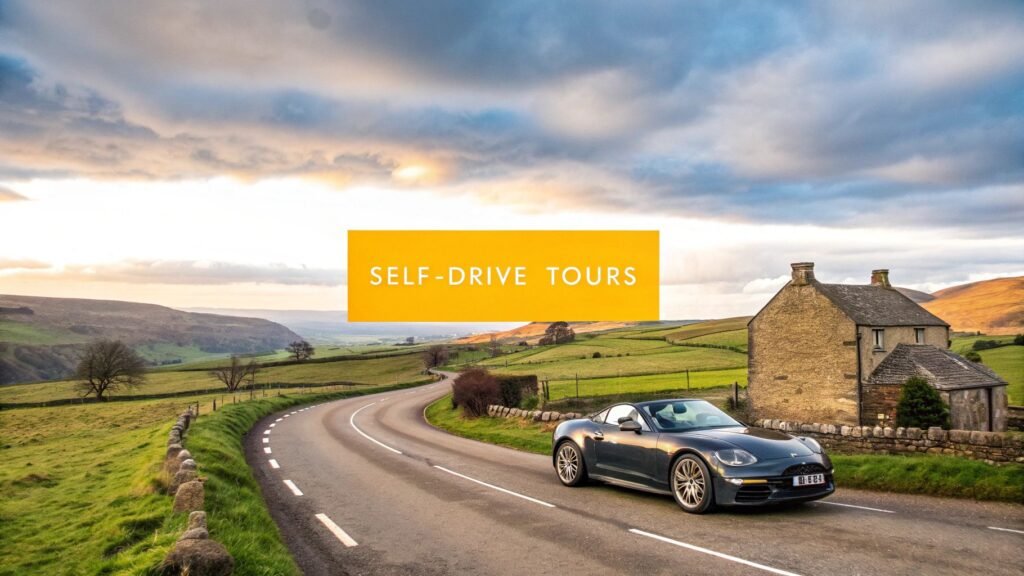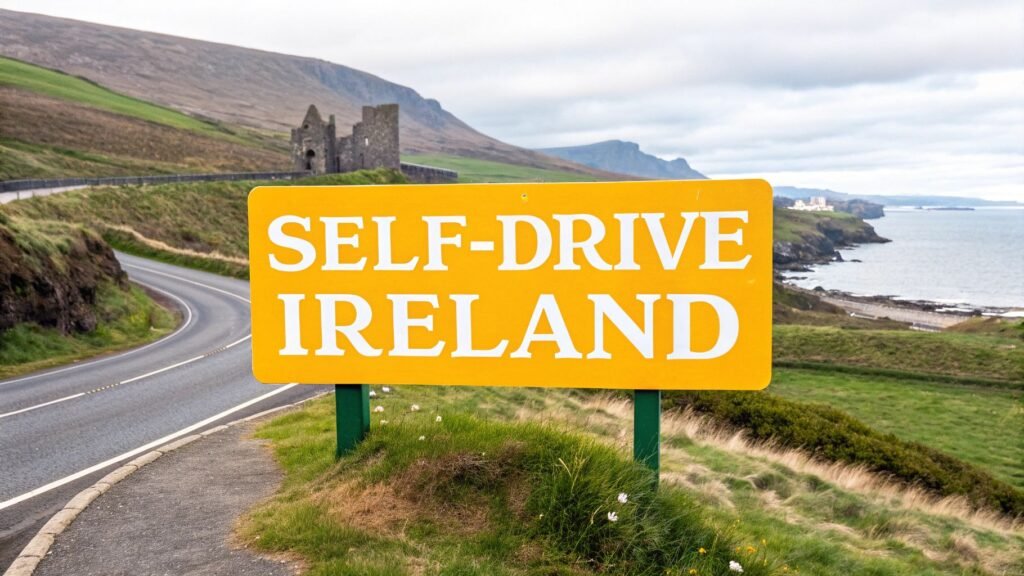Picture the Scottish Highlands. Now, imagine them not swarmed with summer tourists, but hushed and cloaked in a pristine blanket of snow. That’s the real magic of a winter road trip here—a time when the landscape sheds its lush green for a raw, dramatic beauty. A drive through the Scotland Highlands winter is a far more intimate and profound adventure for anyone willing to brave the chill.
Why a Highlands Winter Trip Is Truly Unforgettable
A winter journey into the Highlands is nothing like the postcard pictures you’re used to. It’s an experience you feel in your bones: the crisp, biting air, the mountains shrouded in mist, and a deep silence you can only find in the off-season. With the summer crowds gone, you can stand before icons like Glencoe and Loch Ness and feel like you have them all to yourself. To really get a feel for what makes this place so special, it’s worth reading more about Scotland as a destination.
This isn’t just about seeing the sights; it’s about experiencing them in a completely different light. The low winter sun throws long, theatrical shadows across the glens, turning every view into a photographer’s dream. The days might be shorter, but they’re framed by spectacular sunrises and sunsets—and you often don’t even need an early alarm to catch them.
The distinct lack of other people is a major benefit. This means that parking is a breeze, tourist hotspots are delightfully quiet, and you will barely see another person up on the hills.
What This Guide Will Cover
This guide is born from countless hours on these very roads, designed to get you ready for both the jaw-dropping beauty and the real-world challenges of a self-drive tour. Think of it as your complete roadmap, giving you all the tools you need for a safe, unforgettable trip into Scotland’s winter soul. You can also see how these tips come together in our self-drive tours of Scotland.
My aim here is to give you the full picture, from the nitty-gritty logistics to authentic local experiences. We’ll walk through it all:
- Decoding the Weather: Getting to grips with the wild and wonderfully unpredictable Highland climate.
- Essential Planning: How to pick the right vehicle, book smart accommodation, and build an itinerary with plenty of wiggle room.
- Safe Winter Driving: The absolute non-negotiable skills for handling icy roads and single-track lanes.
- Top Sights & Activities: Finding out what’s actually open and which experiences are uniquely brilliant in winter.
- Smart Packing: A no-nonsense guide to layering up and the essential gear you won’t want to be without.
From the simple pleasure of finding a cosy, open pub to the rare, magical chance of spotting the Northern Lights, this guide will set you up for a journey you’ll never forget.
Decoding Highland Winter Weather
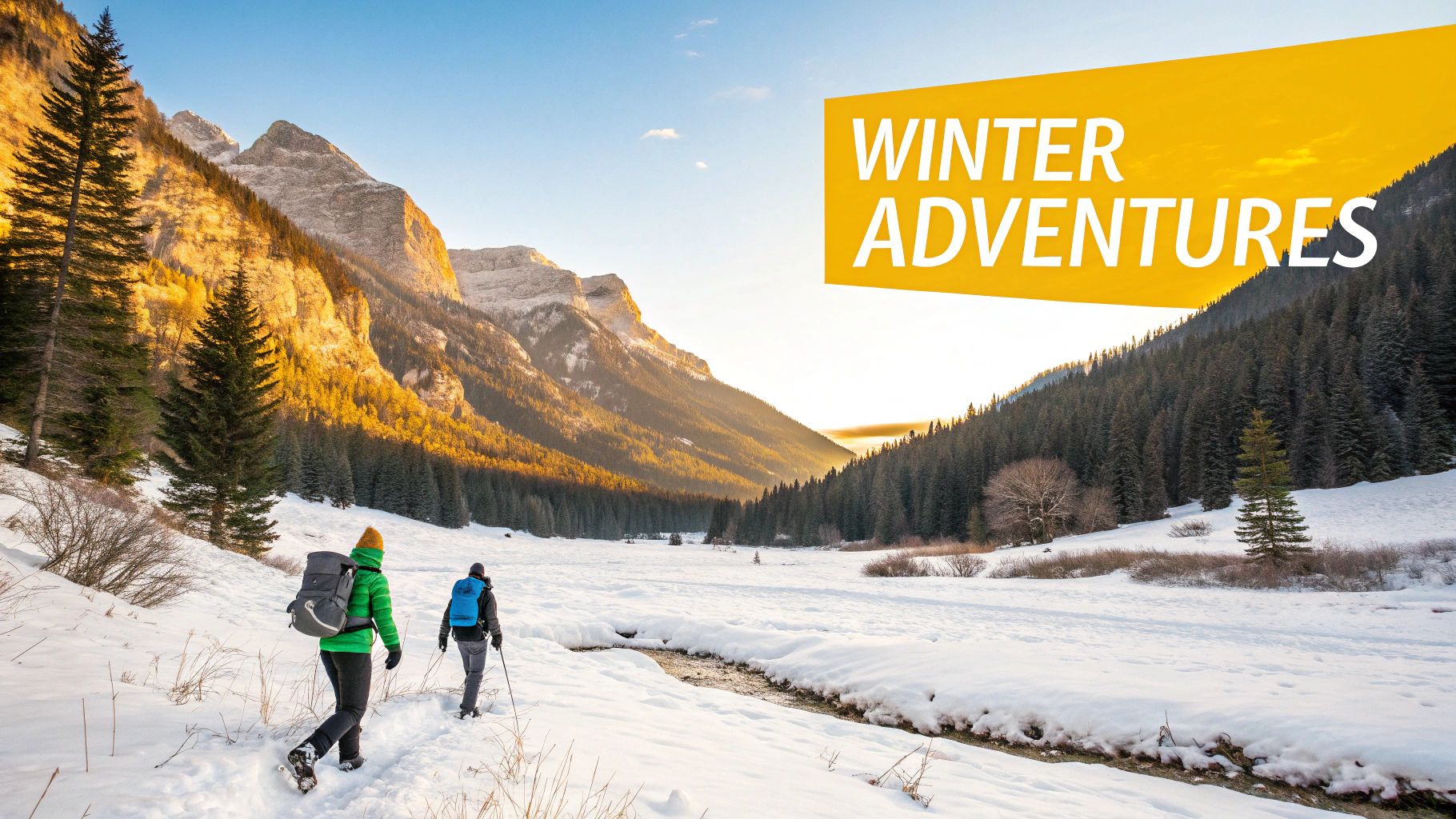
Let’s get one thing straight: understanding the weather is the most important part of planning a winter road trip in the Scottish Highlands. The climate here has a personality all its own—it can be breathtakingly beautiful one moment and turn wild and fierce the next. You have to think of it less as “cold” and more as a dynamic environment that demands respect.
This isn’t meant to scare you off. Quite the opposite. It’s about giving you the knowledge to plan a trip that’s both safe and incredible. It’s completely normal to experience bright sunshine, biting wind, a spot of rain, and a flurry of snow, sometimes all in the same afternoon.
Your best friend on this journey will be flexibility. The forecast for one glen might be totally different from the reality just a few miles down the road. That incredible variability is what makes a Highland winter what it is.
Temperatures and Frost: The Reality on the Ground
While we all dream of that perfect, snow-blanketed landscape, the day-to-day reality is more often a mix of crisp frost, a damp, penetrating cold, and only occasional snow, especially at lower levels. The temperatures can swing quite a bit, so getting a handle on the averages is key for packing the right gear and planning your drives.
Take Inverness, for example. Long-term data shows the average maximum temperature in January sits around 6.3°C. But at night, it drops to a chilly 0.7°C. Frost isn’t a rare event; it’s a regular feature. Inverness sees an average of 10.9 days of air frost in January alone—that means for over a third of the month, you can expect freezing overnight temperatures. You can dig into the specifics for different towns using the Met Office climate data.
This brings up a crucial point for drivers: roads that were just wet during the day can easily turn into slick sheets of ice once the sun goes down.
A common mistake is to only check the daytime high. The overnight low is what truly dictates morning road conditions and whether you’ll be scraping thick ice off your windscreen before you can even start your day’s journey.
Snowfall: What to Realistically Expect
So, will you see snow? The classic Scottish answer is “maybe.” It really all comes down to where you are and the specific week you visit.
- Lowland vs. Highland: Major routes like the A9 and the roads around towns like Inverness and Fort William are priorities for gritters and are often clear, seeing only a light dusting. The real snow is found on the higher mountain passes and remote single-track roads, where it can be deep and stick around.
- The Cairngorms: If you’re set on a snowy wonderland, this national park is your best bet. As one of the highest and coldest parts of the UK, it often has good snow cover for much of the winter, making it a hub for skiing and snowboarding.
- Sudden Changes: A proper blizzard can roll in surprisingly fast, changing the entire landscape and making roads impassable in a matter of hours. This is exactly why checking the weather and traffic reports isn’t just a good idea—it’s an essential part of your daily routine.
The Challenge of Limited Daylight
Beyond the cold and snow, the biggest factor that will shape your itinerary is the short amount of daylight. In the dead of winter, you might only get 7 to 8 hours of usable light to drive and see the sights.
Sunrise can be as late as 9:00 AM, with the sun dipping below the horizon before 4:00 PM. This compressed timeframe forces you to slow down and adopt a different rhythm.
Planning Around the Light:
- Shorter Driving Days: Forget trying to conquer huge distances. Plan shorter drives so you know you’ll reach your B&B or hotel before it gets pitch black.
- Early Starts: Even with a late sunrise, being organized and ready to hit the road as soon as it’s light is the best way to make the most of your day.
- Prioritise Sights: Pick your absolute must-see for the day and plan your route around that. Anything else is a bonus if you have the time and the weather plays ball.
Don’t see this as a drawback. That low winter sun creates the most incredible, dramatic light for photos. And honestly, the long, dark evenings are the perfect excuse to find a cozy pub with a roaring fire.
Your Essential Winter Trip Planning Blueprint
A truly memorable winter trip through the Highlands doesn’t just happen; it’s born from careful and thoughtful planning. This is where you lay the groundwork for your entire adventure. Getting the logistics sorted out before you even think about packing is the secret to transforming a potentially stressful trip into a seamless, incredible experience. Think of this as your mission control for an epic self-drive Scotland Highlands winter tour.
Your adventure begins long before you put the key in the ignition. It starts with picking the right vehicle, mapping out a sensible route, and booking your accommodation. Every single one of these choices will directly shape your safety and enjoyment on those beautifully quiet, wintry roads.
Choosing Your Winter Vehicle
Let’s get straight to the point: the vehicle you choose is one of the most critical decisions you’ll make. Winter conditions in the Highlands can be a mixed bag of ice, slush, and snow, and it can all change in the blink of an eye. Your standard rental car with summer tyres just won’t cut it—in fact, it can be downright dangerous.
You really have two solid, highly recommended options:
- A 4×4 Vehicle: An all-wheel or four-wheel-drive vehicle gives you much better grip and stability. This is a massive advantage when you’re navigating steep, winding, or snow-dusted roads. It’s a huge confidence booster and a significant safety net.
- A Car with Winter Tires: If a 4×4 isn’t in the cards, the next best thing is a standard car fitted with proper winter tyres (and I don’t mean “all-season” tyres). These are made from a softer rubber compound that stays flexible in the cold, giving you far more traction on icy surfaces than summer tyres ever could.
When you book your rental, be specific. Tell them you need a car suitable for winter driving in the Highlands. Most rental companies in Scotland are used to this request and will know exactly what you need.
Crafting a Realistic Itinerary
I’ve seen it time and time again: the biggest mistake winter travellers make is trying to cram too much into their trip. With limited daylight—sometimes as few as 7-8 hours a day—and the very real possibility of weather delays, a jam-packed summer itinerary is just asking for trouble. The key to a relaxed trip is to build in breathing room.
Your itinerary should be less of a rigid schedule and more of a flexible guide. The real goal is to embrace the slower, more deliberate pace of winter, not fight against it. Always put your safety and the quality of your experience ahead of ticking off a long list of places.
A great way to do this is to build “buffer days” into your plan. If a big storm rolls in and a road closes, a buffer day means you can simply wait it out without throwing your entire trip into chaos. It also gives you the freedom to linger a little longer in a spot you’ve fallen in love with. If you want some inspiration for a well-paced journey, have a look at a pre-planned route like this Taste of Scotland 8-Days Self-Drive Tour and adapt its flow for winter conditions.
To help you stay on track, I’ve put together a simple checklist covering the essentials.
Winter Self-Drive Trip Planning Checklist
This table breaks down the critical planning tasks to ensure your Highlands road trip is both safe and unforgettable. Run through these points before you go.
| Planning Area | Key Action | Pro Tip |
|---|---|---|
| Vehicle | Book a 4×4 or a car with dedicated winter tyres. | Be explicit with the rental company about your needs. Confirm your booking a week before you travel. |
| Itinerary | Plan a flexible route with shorter driving days and buffer days. | Prioritize must-see sights, but have backup plans. Check road conditions daily. |
| Accommodation | Pre-book all your stays, especially in remote areas. | Many places close for winter (Nov-Mar). Call ahead to confirm reservations directly with the hotel or B&B. |
| Fuel | Map out petrol stations along your route. | Never let your fuel tank drop below half-full. Stations can be few and far between. |
| Insurance | Verify your policy covers trip interruption due to “adverse weather.” | Read the fine print! This is a common exclusion in basic policies and can save you a lot of money. |
Tackling these key areas proactively is the difference between a trip that runs smoothly and one that’s fraught with last-minute stress.
Securing Accommodation and Fuel Stops
It’s important to know that many hotels, B&Bs, and even campsites in the smaller Highland villages shut down for the winter season, typically from November through March. You absolutely cannot assume you’ll be able to find a room on the spot.
Being proactive here means you’ll always have a warm, welcoming place to retreat to at the end of a day’s exploring.
Essential Travel Insurance and Packing
Finally, let’s talk about the small print. Dig out your travel insurance policy and make sure it covers trip cancellations or delays due to “adverse weather.” This can be a common exclusion in cheaper policies, but it’s your financial safety net if a major storm forces you to change your plans.
Packing smart is the other cornerstone of a good trip. The infographic below breaks down the layering system that every seasoned cold-weather traveler swears by.
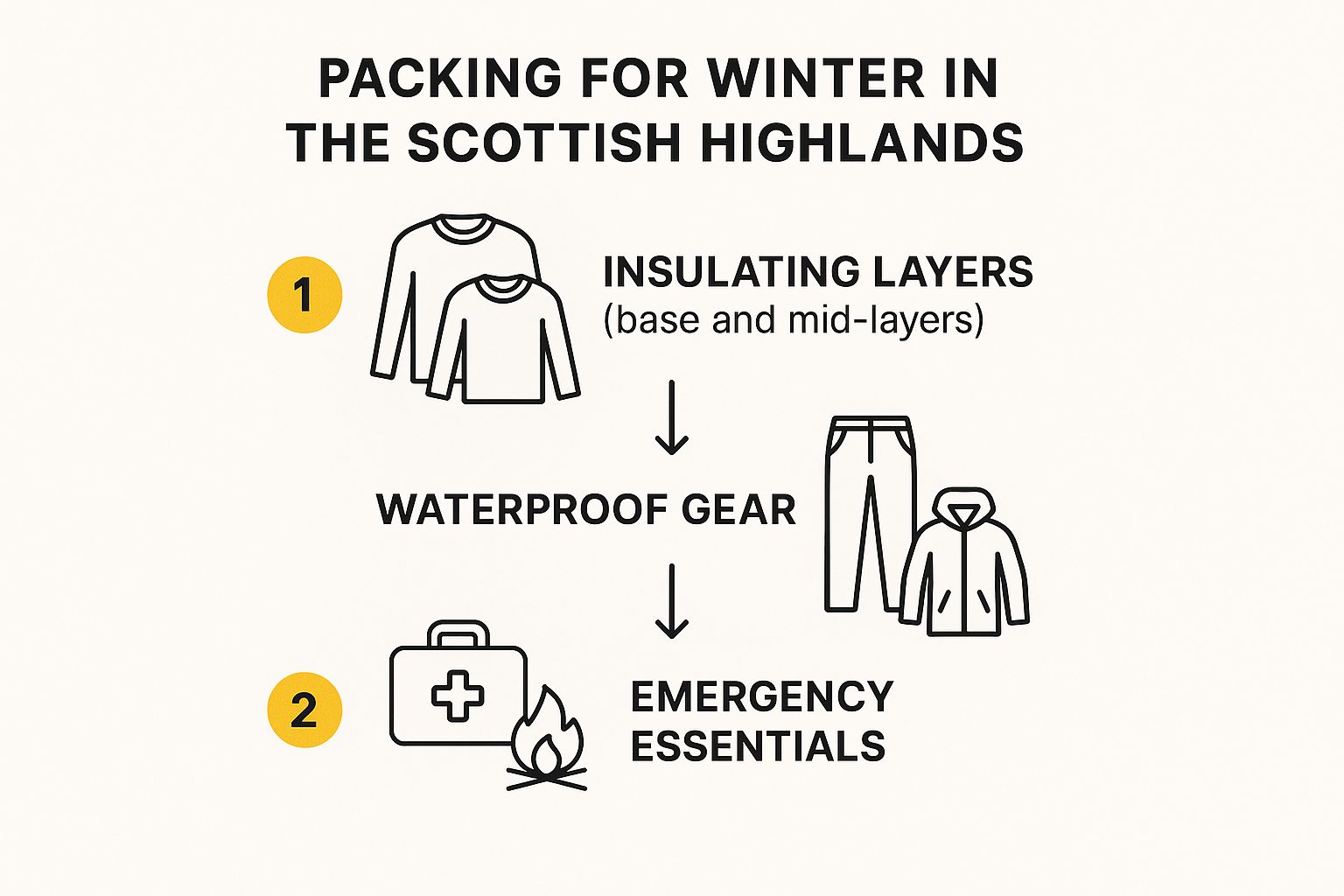
As you can see, staying warm and dry isn’t about one big, bulky jacket. It’s about a system of layers working in harmony. Each piece, from the moisture-wicking base layer against your skin to the protective outer shell, plays a vital role in keeping you comfortable and ready for whatever the Highland weather throws at you.
How to Drive Safely on Wintry Highland Roads
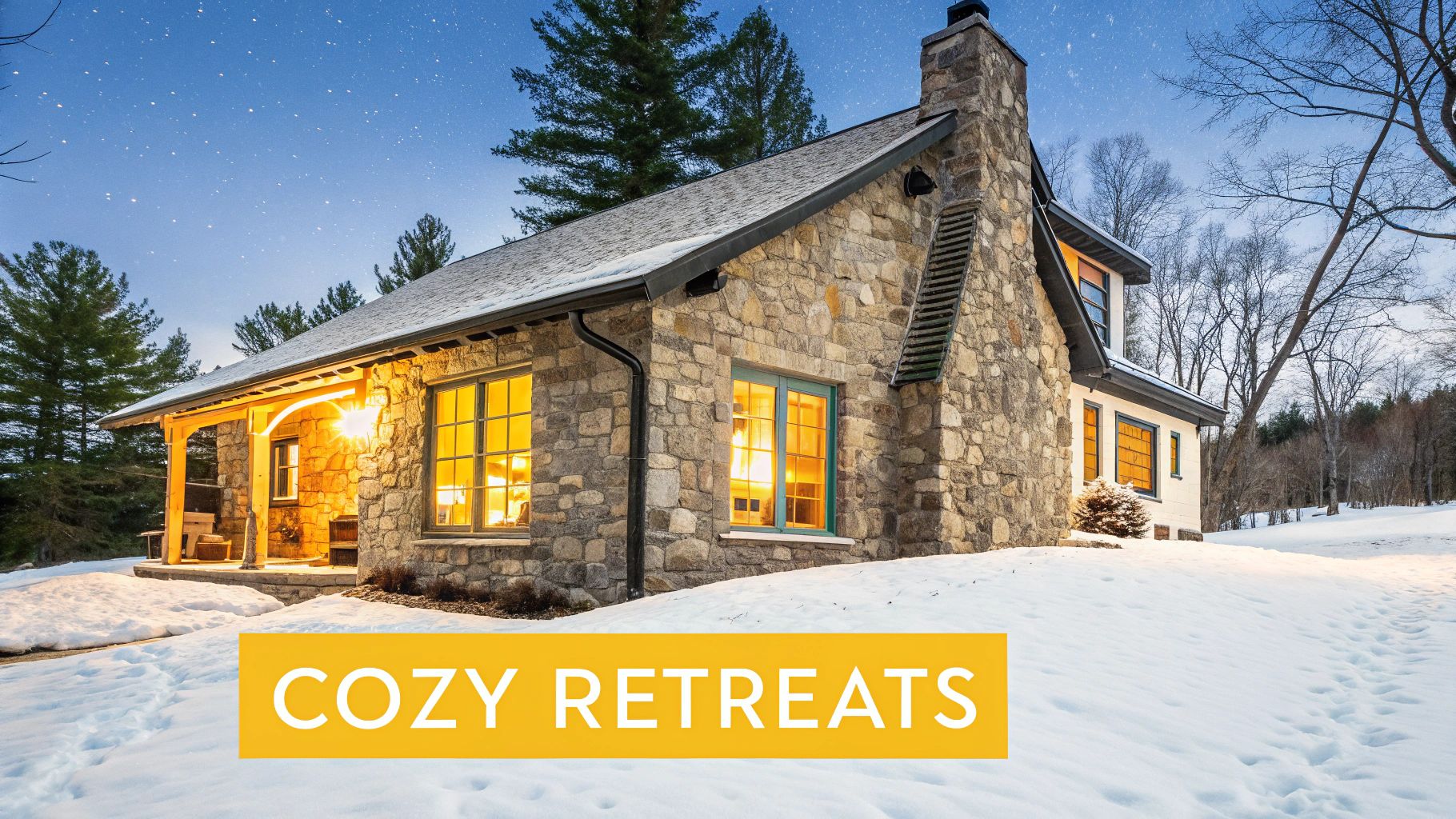
Driving is the absolute heart of a Scotland Highlands winter trip, but it’s also where you’ll find the biggest hurdles. The conditions up here demand respect. A road that looks perfectly clear one minute can turn into a slick, icy hazard the next, and getting a feel for these rapid changes is what makes or breaks a trip.
This isn’t about being scared of the roads; it’s about building the confidence to handle them. With the right preparation and a healthy dose of caution, you can navigate the Highlands feeling completely in control, ready for whatever the journey throws at you.
Master the Daily Rituals
Your most important daily habits will boil down to two things: checking the weather forecast and checking the traffic reports. Think of it as your morning briefing before heading out on a mission. The weather in the Highlands can turn on a dime, and a road that was open last night could easily be closed by morning due to fresh snow or an accident.
Traffic Scotland is your absolute best friend for this. Their website and app give you live, real-time updates on road closures, incidents, and where the gritters have been. I can’t stress this enough: check it before you even turn the key and, if you can, have a passenger check it during the day when you’re safely parked.
A classic mistake I see visitors make is assuming the main arteries, like the A9, will always be open. Yes, they’re a priority for the road crews, but a sudden blizzard can shut down even the most critical routes. Never start a day’s drive without knowing what’s happening on the road ahead.
The raw power of a Highland winter has shaped history here. Back in the 17th century, heavy snow could bring all travel to a standstill for weeks. This had huge consequences, like when the MacDonalds’ journey to Inveraray was delayed, a factor that preceded the infamous Massacre of Glencoe. We have modern tech now, but the weather still commands respect. You can get a feel for how the climate has shaped this land by reading about the environmental past of Argyll.
Handling Icy Roads and Single Tracks
Driving on ice isn’t about dramatic steering or slamming on the brakes. It’s about being gentle and deliberate. Imagine you’ve got a full cup of hot tea on the dashboard and you don’t want to spill a single drop. Every movement—steering, accelerating, braking—needs to be smooth and measured. If you feel the car start to skid, the key is to take your feet off the pedals completely and steer gently into the direction of the skid until you feel the tyres grip again.
Single-track roads are a whole other beast in winter. The crucial passing places can easily disappear under a blanket of snow, making it tough to know where to pull over.
- Look Far Ahead: Keep your eyes scanning the horizon for oncoming cars so you can spot the next passing place well in advance.
- Be Ready to Reverse: It’s just common courtesy and good sense—whoever is closer to a passing place (or has an easier path to it) should be the one to back up.
- Give Way to Uphill Traffic: This is a firm rule of the road. If you meet someone on a steep, icy hill, the driver going uphill has the right of way. It’s far more difficult and dangerous for them to stop and try to get going again on a slippery slope.
Your In-Car Winter Survival Kit
Even if you’re only planning a short drive, you need a winter survival kit in your car. Getting stuck because of a breakdown or a sudden road closure is a real possibility, and having these items can make a world of difference. Make sure your kit is easy to grab, not buried under all your luggage in the boot.
Here’s a good starting point for your emergency pack:
- Warmth & Visibility: A warm blanket or even a sleeping bag, plus extra layers like a hat, gloves, scarf, and a high-vis jacket.
- Food & Drink: A flask of something hot, a bottle of water, and some high-energy snacks like chocolate or granola bars.
- Essential Tools: A fully charged phone and a portable power bank, a torch with spare batteries, a small shovel, an ice scraper, and de-icer.
- Safety Gear: A first-aid kit and any personal medication you rely on.
By taking these sensible precautions, from your daily checks to how you handle the car, you stop being just a tourist and become a capable, confident winter explorer, ready to safely enjoy one of the world’s most beautiful landscapes.
Top Sights and Activities for Your Winter Itinerary
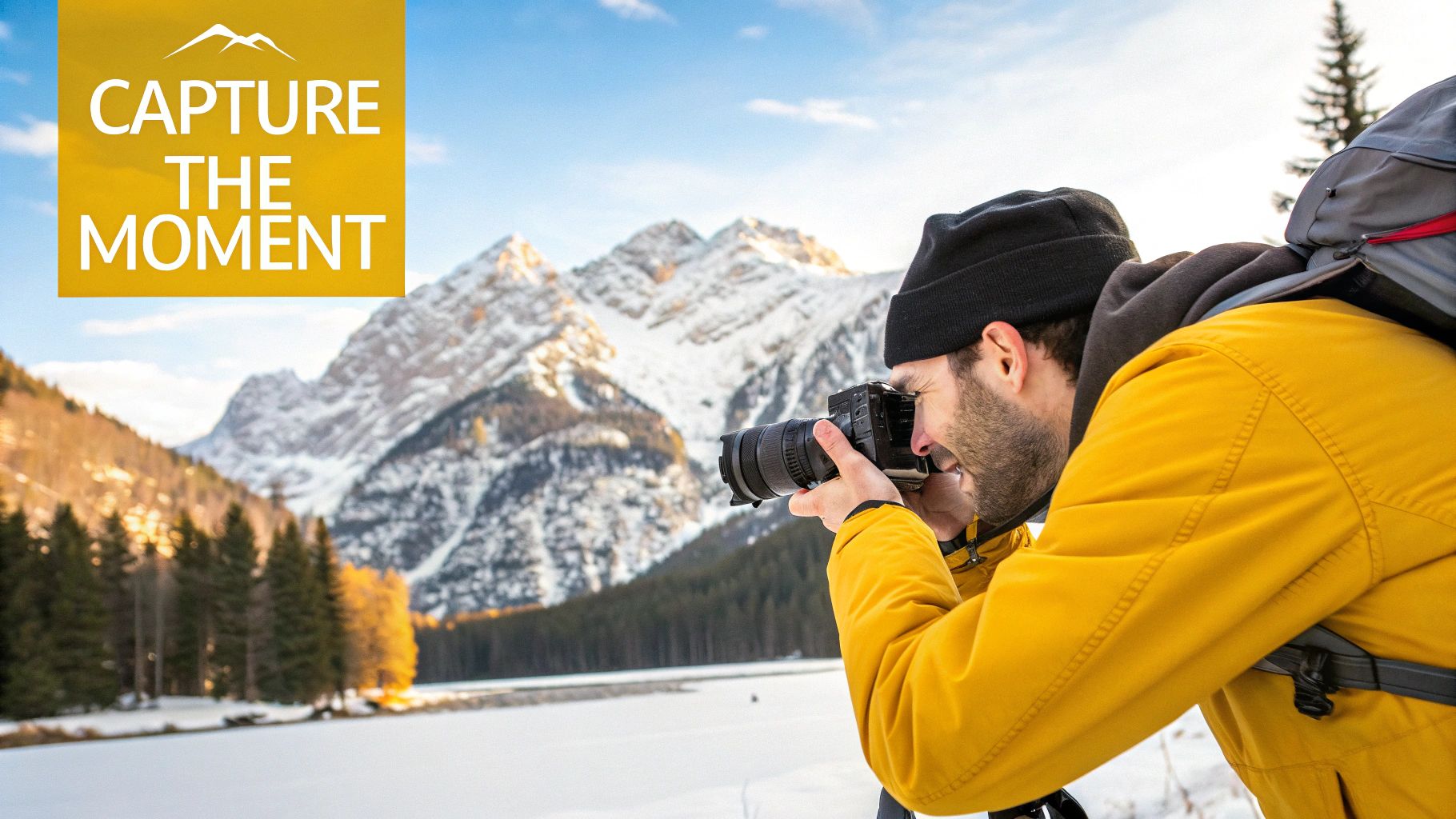
A winter trip through the Scotland Highlands isn’t about frantically ticking off a list of sights, many of which might be closed anyway. It’s about seeing the iconic landmarks you know from pictures in a completely new, dramatic light. The summer crowds are long gone, leaving behind an incredible sense of peace and wildness.
This seasonal shift completely transforms well-known spots. Glens feel moodier, lochs seem more mysterious, and the silence is profound. The key is knowing where to go and what to do to really soak in the crisp air, the low sun, and that serene atmosphere.
Witness Iconic Landscapes in Solitude
The single biggest perk of visiting in winter? The quiet. You can stand before some of Scotland’s most famous views without the usual throng of people, allowing for a much more personal and powerful connection with the land.
- Glencoe: Honestly, Glencoe is arguably more powerful in winter. The mountains feel like they’re looming over the valley with a stark, brooding presence. The low sun casts long, dramatic shadows that carve out every contour of peaks like the famous Buachaille Etive Mòr. Just be sure to use the designated lay-bys for those jaw-dropping photos and keep an eye on road conditions.
- Loch Ness: With the tour boats docked and the A82 much quieter, Loch Ness takes on a truly mysterious quality. The water is often dark and glassy, perfectly reflecting the frost-tipped trees along its banks. It’s the ideal time for a quiet walk along the shore near Dores or a visit to the hauntingly beautiful Urquhart Castle, which often stays open with reduced hours.
- The Isle of Skye: While some B&Bs and restaurants will be closed, Skye under a blanket of snow is pure magic. Sights like the Old Man of Storr and the Quiraing are transformed into something otherworldly. Driving here demands extra care, but the reward is seeing these famous locations without the crowds—it makes the experience feel truly special.
Embrace Unique Winter Activities
Beyond just looking at things, winter opens the door to activities that are either impossible or just not the same during other times of the year. It’s a chance to connect directly with the season.
People often imagine the Highlands buried under feet of snow, but the climate is actually milder than you might think thanks to the influence of the ocean. It’s certainly colder than most of the UK, but not Arctic. This creates a perfect environment for specific winter pursuits. Snowfall is most reliable at higher elevations, which is why the region is a magnet for winter sports. In a good season, the Cairngorms National Park can attract over 200,000 skiers and snowboarders. You can dig into the specifics by checking out reports from the Met Office on regional averages.
This unique weather balance means you can often mix and match your days perfectly.
Winter in the Highlands offers a special kind of duality. You can spend a day on an accessible, low-level hike enjoying crisp, clear air, and then retreat to a pub with a roaring fire as the stars begin to fill an incredibly dark sky. It’s a perfect blend of adventure and comfort.
Finding Coziness and Wildlife
When the short day draws to a close, your focus can shift indoors or to the natural wonders that emerge in the cold. These activities are the perfect way to round out a day of driving and exploring.
H3: Cozy Up with a Dram
There’s nothing better than a warming dram of whisky after a day out in the cold, and luckily, many distilleries stay open through the winter. A tour is a fantastic way to escape the elements and learn something new.
- Check Ahead: Always, always verify their winter opening hours online or by phone. Many run on a reduced schedule.
- Book a Tour: Pre-booking is often essential in the off-season to guarantee a spot.
- Enjoy Responsibly: Don’t forget you’re on a self-drive trip. Make sure you have a designated driver, or better yet, buy a few bottles to enjoy back at your accommodation later.
H3: Go Stargazing
With long nights and next to no light pollution, the Highlands are one of the best places in the UK for stargazing. On a clear, moonless night, the view is simply breathtaking. For the best experience, head to an official Dark Sky Park like the Cairngorms.
H3: Spot Iconic Wildlife
Winter is an excellent time to see some of Scotland’s most famous residents. Red deer often come down from the high mountains to find food, making them much easier to spot against the snow, especially in places like Glen Etive. Keep an eye out for ptarmigan in their white winter plumage or even a majestic golden eagle soaring high above.
Packing Smart for Warmth and Safety
What you pack for a Scotland Highlands winter trip will make or break your experience. Forget about bringing one massive, bulky coat. The real secret, and what seasoned locals all know, is mastering the art of layering. Think of it as a three-part system designed to keep you warm and dry, no matter what the famously fickle Scottish weather throws at you.
It all starts with a moisture-wicking base layer right against your skin. Its sole purpose is to pull sweat away from your body, preventing that dreaded cold, clammy feeling. Over that, you’ll need an insulating mid-layer—think a good fleece or a light down jacket—to trap your precious body heat. The final piece of the puzzle is a completely waterproof and windproof outer shell to shield you from rain, sleet, and biting winds.
Packing for the Highlands is like preparing a small expedition. You need to anticipate changing conditions and be self-sufficient, as the right gear can turn a potentially miserable experience into a comfortable adventure.
The Non-Negotiable Clothing and Accessories
Once you’ve got your core layers sorted, a few key accessories are absolutely essential for staying comfortable and safe. These are the items that make all the difference when the temperature really plummets and the wind starts to howl.
Here’s your must-have checklist:
- Waterproof Hiking Boots: Make sure they have excellent grip. Icy trails and soggy, boggy ground are everywhere, so solid traction isn’t just a suggestion—it’s a necessity.
- Warm Hat and Gloves: A thermal hat and a pair of waterproof, insulated gloves are non-negotiable. You lose a surprising amount of body heat through your head and hands.
- Thermal Socks: Don’t skimp here. Pack several pairs of wool or high-quality synthetic thermal socks to keep your feet toasty and dry.
- Gaiters: These might seem like overkill, but these simple fabric wraps for your lower legs are brilliant for stopping snow and water from sneaking into the top of your boots.
Essential Gear Beyond Your Wardrobe
Proper preparation goes well beyond just what you wear. The days are short, and the cold can drain batteries in a flash, so a few extra pieces of kit are vital for any winter drive through the Highlands. A well-stocked pack means you’re truly ready for whatever comes your way.
Must-Have Road Trip Gadgets:
- Headtorch: With the sun dipping below the horizon before 4 PM, a headtorch is a must. You’ll need it for everything from getting back to the car after a short walk to simply finding your way to your B&B’s front door in the dark.
- Thermos Flask: A hot drink on a frosty day is more than just a nice treat; it’s a huge morale booster. Fill one up with tea, coffee, or even some hot soup before you head out. For a true taste of local warmth, you might find inspiration in a culinary self-drive tour of Scotland.
- Power Bank: Cold weather is notorious for killing phone batteries. A fully charged portable power bank ensures your phone is always ready for navigation, photos, and, most importantly, any emergencies.
Got a Few Lingering Questions? We’ve Got Answers
Even the most well-thought-out plan can leave you with a few nagging questions. That’s perfectly normal. Let’s tackle some of the most common queries we hear from travellers planning a winter trip to the Scottish Highlands. Consider this your final pre-flight check to iron out any last-minute uncertainties.
What Are My Chances of Seeing the Northern Lights?
Yes, it’s absolutely possible to see the Northern Lights (the Aurora Borealis) in Scotland! While it’s never a guarantee, the long, dark nights of winter give you the best possible shot. The further north you get, and the further you are from the glow of towns and cities, the better your odds.
For the serious aurora hunters, these spots are your best bet:
- The Cairngorms National Park is an official Dark Sky Park.
- The wild, remote northwest coast around Ullapool.
- The Orkney and Shetland Islands (if you’re venturing that far), which offer the highest probability in the UK.
Catching them comes down to two things: strong solar activity and, crucially, clear skies. Before you head out into the cold, always check a reliable forecast. I personally recommend AuroraWatch UK from Lancaster University; it’s what the locals use.
Will I Find Anything Open in Winter?
This is a classic “it depends” situation. In the main Highland hubs like Inverness, Fort William, and Aviemore, you’ll find that most pubs, restaurants, and essential shops are open for business year-round. Finding a warm, cosy pub for a meal after a day of exploring won’t be a problem there.
It’s a different story in the smaller, more remote villages. Many of these places run on a seasonal rhythm. That means a lot of family-run cafes, independent shops, visitor centres, and B&Bs might shut their doors from November through to March.
The golden rule here is simple: always check opening times online or call ahead. It takes two minutes and can save you from a long, disappointing drive to a locked door, especially if you’ve got your heart set on a particular distillery tour or castle visit.
What’s the Biggest Mistake People Make on a Winter Trip?
Hands down, the biggest mistake is underestimating the weather and trying to cram too much in. It’s so tempting to create an ambitious, jam-packed itinerary, but when you only have 7-8 hours of daylight, it’s a recipe for disaster. You end up rushing, stressed, and driving on tricky roads in the dark.
The secret to a truly great winter trip is embracing flexibility. Plan for shorter driving days. Build buffer days into your schedule. This way, if a snowstorm rolls in, it’s a cozy inconvenience, not a trip-ruining catastrophe. The key is to prioritize a safe, enjoyable experience over ticking off a rigid checklist.
At BTOURS, we design self-drive tours that give you the freedom to explore incredible destinations like the Scottish Highlands at your own pace, with all the planning handled. Discover our curated journeys and start your adventure.


